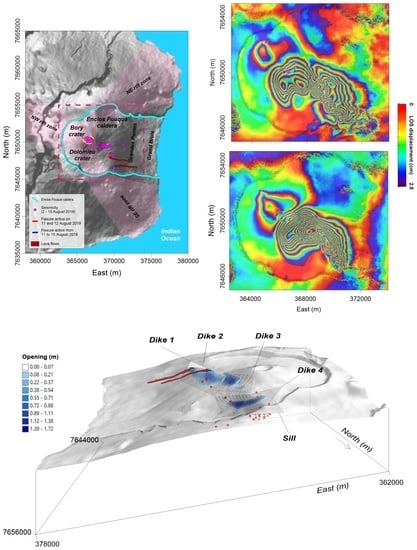The August 2019 Piton de la Fournaise (La Réunion Island) Eruption: Analysis of the Multi-Source Deformation Pattern Detected through Sentinel-1 DInSAR Measurements
Abstract
:1. Introduction
2. Geological Setting and Eruptive History
3. DInSAR Measurements and Seismological Data
3.1. DInSAR Measurements
3.2. Seismological Data
4. Analytical Modeling
5. Discussion
6. Conclusions
- The DInSAR measurements highlight a complex deformation pattern, which includes the ground displacements generated during both the pre- and co-eruptive phases.
- The performed modeling reveals the presence of five volcanic sources (i.e., one sill-like source and four dikes). Their concomitant action generated the observed deformation pattern. These results are also in good agreement with field evidence, such as the location of the opened fissures and other geophysical evidence already known in the literature.
- Our modeling results were validated against the epicentral and hypocentral analysis of the occurred volcano–tectonic earthquakes. The sources inferred from the inversion of the DInSAR measurements correlate well with the spatial distribution and the temporal evolution of the recorded seismicity.
Supplementary Materials
Author Contributions
Funding
Institutional Review Board Statement
Informed Consent Statement
Data Availability Statement
Acknowledgments
Conflicts of Interest
References
- Poland, M.P.; Peltier, A.; Bonforte, A.; Puglisi, G. The spectrum of persistent volcanic flank instability: A review and proposed framework based on Kīlauea, Piton de la Fournaise, and Etna. J. Volc. Geotherm. Res. 2017, 339, 63–80. [Google Scholar] [CrossRef]
- Ebmeier, S.K.; Andrews, B.J.; Araya, M.C.; Arnold, D.W.D.; Biggs, J.; Cooper, C.; Cottrell, E.; Furtney, M.; Hickey, J.; Jay, J.J.J.A.V.; et al. Synthesis of global satellite observations of magmatic and volcanic deformation: Implications for volcano monitoring & the lateral extent of magmatic domains. J. Appl. Volc. 2018, 7, 2. [Google Scholar] [CrossRef]
- Furtney, M.A.; Pritchard, M.E.; Biggs, J.; Carn, S.A.; Ebmeier, S.K.; Jay, J.A.; Kilbride, B.T.M.; Reath, K.A. Synthesizing multi-sensor, multi-satellite, multi-decadal datasets for global volcano monitoring. J. Volc. Geotherm. Res. 2018, 365, 38–56. [Google Scholar] [CrossRef]
- Valade, S.; Ley, A.; Massimetti, F.; D’Hondt, O.; Laiolo, M.; Coppola, D.; Loibl, D.; Hellwich, O.; Walter, T.R. Towards Global Volcano Monitoring Using Multisensor Sentinel Missions and Artificial Intelligence: The MOUNTS Monitoring System. Remote Sens. 2019, 11, 1528. [Google Scholar] [CrossRef] [Green Version]
- Sparks, R. Forecasting volcanic eruptions. Earth Planet. Sci. Lett. 2003, 210, 1–15. [Google Scholar] [CrossRef]
- Segall, P. Volcano deformation and eruption forecasting. Geol. Soc. Lond. Spec. Publ. 2013, 380, 85–106. [Google Scholar] [CrossRef]
- White, R.; McCausland, W. Volcano-tectonic earthquakes: A new tool for estimating intrusive volumes and forecasting eruptions. J. Volcanol. Geotherm. Res. 2016, 309, 139–155. [Google Scholar] [CrossRef] [Green Version]
- Dzurisin, D. Volcano Deformation: New Geodetic Monitoring Techniques; Springer Science & Business Media: Berlin/Heidelberg, Germany, 2006. [Google Scholar]
- Battaglia, M.; Cervelli, P.F.; Murray, J.R. dMODELS: A MATLAB software package for modeling crustal deformation near active faults and volcanic centers. J. Volcanol. Geotherm. Res. 2013, 254, 1–4. [Google Scholar] [CrossRef]
- Dzurisin, D. Volcano geodesy: Challenges and opportunities for the 21st century. Philos. Trans. R. Soc. Lond. Ser. A Math. Phys. Eng. Sci. 2000, 358, 1547–1566. [Google Scholar] [CrossRef]
- Aoki, Y. Space geodetic tools provide early warnings for earthquakes and volcanic eruptions. J. Geophys. Res. Solid Earth 2017, 122, 3241–3244. [Google Scholar] [CrossRef] [Green Version]
- Biggs, J.; Pritchard, M.E. Global Volcano Monitoring: What Does It Mean When Volcanoes Deform? Elements 2017, 13, 17–22. [Google Scholar] [CrossRef] [Green Version]
- Fernandez, J.; Pepe, A.; Poland, M.P.; Sigmundsson, F. Volcano Geodesy: Recent developments and future challenges. J. Volcanol. Geotherm. Res. 2017, 344, 1–12. [Google Scholar] [CrossRef]
- Oehler, J.-F.; Lénat, J.-F.; Labazuy, P. Growth and collapse of the Reunion Island volcanoes. Bull. Volcanol. 2007, 70, 717–742. [Google Scholar] [CrossRef]
- Lénat, J.-F. Geodynamic Setting of La Réunion. In Active Volcanoes of the Southwest Indian Ocean; Bachelery, P., Lenat, J.F., Di Muro, A., Michon, L., Eds.; Springer: Berlin/Heidelberg, Germany, 2016; Active Volcanoes of the World. [Google Scholar] [CrossRef]
- Pandey, O.P. Geodynamic and Geologic Evolution of Indian Continent: A Brief History. In Geodynamic Evolution of the Indian Shield: Geophysical Aspects; Springer: Cham, Switzerland, 2020; pp. 1–39. [Google Scholar]
- Richter, N.; Froger, J.-L. The role of Interferometric Synthetic Aperture Radar in Detecting, Mapping, Monitoring, and Modelling the Volcanic Activity of Piton de la Fournaise, La Réunion: A Review. Remote Sens. 2020, 12, 1019. [Google Scholar] [CrossRef] [Green Version]
- Famin, V.; Welsch, B.; Okumura, S.; Bachèlery, P.; Nakashima, S. Three differentiation stages of a single magma at Piton de la Fournaise volcano (Reunion hot spot). Geochem. Geophys. Geosyst. 2009, 10. [Google Scholar] [CrossRef] [Green Version]
- Rivet, D.; Brenguier, F.; Clarke, D.; Shapiro, N.; Peltier, A. Long-term dynamics of Piton de la Fournaise volcano from 13 years of seismic velocity change measurements and GPS observations. J. Geophys. Res. Solid Earth 2014, 119, 7654–7666. [Google Scholar] [CrossRef]
- Ren, C.X.; Peltier, A.; Ferrazzini, V.; Rouet-Leduc, B.; Johnson, P.A.; Brenguier, F. Machine Learning Reveals the Seismic Signature of Eruptive Behavior at Piton de la Fournaise Volcano. Geophys. Res. Lett. 2020, 47. [Google Scholar] [CrossRef] [Green Version]
- Peltier, A.; Staudacher, T.; Bachèlery, P.; Cayol, V. Formation of the April 2007 caldera collapse at Piton de La Fournaise volcano: Insights from GPS data. J. Volcanol. Geotherm. Res. 2009, 184, 152–163. [Google Scholar] [CrossRef]
- Staudacher, T.; Ferrazzini, V.; Peltier, A.; Kowalski, P.; Boissier, P.; Catherine, P.; Lauret, F.; Massin, F. The April 2007 eruption and the Dolomieu crater collapse, two major events at Piton de la Fournaise (La Réunion Island, Indian Ocean). J. Volcanol. Geotherm. Res. 2009, 184, 126–137. [Google Scholar] [CrossRef]
- Peltier, A.; Villeneuve, N.; Ferrazzini, V.; Testud, S.; Ali, T.H.; Boissier, P.; Catherine, P. Changes in the Long-Term Geophysical Eruptive Precursors at Piton de la Fournaise: Implications for the Response Management. Front. Earth Sci. 2018, 6. [Google Scholar] [CrossRef]
- Global Volcanism Program. Report on Piton de la Fournaise (France). In Weekly Volcanic Activity Report, 14–20 August 2019; Sennert, S.K., Ed.; Smithsonian Institution and US Geological Survey: Washington, DC, USA, 2019. [Google Scholar]
- Bonneville, A.; Barriot, J.P.; Bayer, R. Evidence from geoid data of a hotspot origin for the southern Mascarene Plateau and Mascarene Islands (Indian Ocean). J. Geophys. Res. Earth Surf. 1988, 93, 4199–4212. [Google Scholar] [CrossRef]
- McDougall, I. The geochronology and evolution of the young volcanic island of Réunion, Indian Ocean. Geochim. et Cosmochim. Acta 1971, 35, 261–288. [Google Scholar] [CrossRef]
- Quidelleur, X.; Holt, J.W.; Salvany, T.; Bouquerel, H. New K-Ar ages from La Montagne massif, Réunion Island (Indian Ocean), supporting two geomagnetic events in the time period 2.2–2.0 Ma. Geophys. J. Int. 2010, 182, 699–710. [Google Scholar] [CrossRef] [Green Version]
- Delibrias, G.; Guillier, M.-T.; Labeyrie, J. Gif Natural Radiocarbon Measurements X. Radiocarbon 1986, 28, 9–68. [Google Scholar] [CrossRef] [Green Version]
- Salvany, T.; Lahitte, P.; Nativel, P.; Gillot, P.-Y. Geomorphic evolution of the Piton des Neiges volcano (Réunion Island, Indian Ocean): Competition between volcanic construction and erosion since 1.4 Ma. Geomorphology 2012, 136, 132–147. [Google Scholar] [CrossRef]
- Labazuy, P.; Oehler, J.-F.; Lénat, J.-F. Recurrence of major flank landslides during the last 2-Ma-history of Reunion Island. Bull. Volcanol. 2004, 66, 585–598. [Google Scholar] [CrossRef]
- Gillot, P.-Y.; Nativel, P. Eruptive history of the Piton de la Fournaise volcano, Reunion Island, Indian Ocean. J. Volcanol. Geotherm. Res. 1989, 36, 53–65. [Google Scholar] [CrossRef]
- Merle, O.; Mairine, P.; Michon, L.; Bachelery, P.; Smietana, M. Calderas, landslides and paleo-canyons on Piton de la Fournaise volcano (La Réunion Island, Indian Ocean). J. Volcanol. Geotherm. Res. 2010, 189, 131–142. [Google Scholar] [CrossRef]
- Lénat, J.-F.; Bachelery, P.; Merle, O. Anatomy of Piton de la Fournaise volcano (La Réunion, Indian Ocean). Bull. Volcanol. 2012, 74, 1945–1961. [Google Scholar] [CrossRef]
- Michon, L.; Ferrazzini, V.; Di Muro, A. Magma paths at Piton de la Fournaise volcano. In Active Volcanoes of the Southwest Indian Ocean; Springer: Berlin/Heidelberg, Germany, 2016; pp. 91–106. [Google Scholar]
- Mairine, P.; Bachèlery, P. Major erosional period in the building of Piton de la Fournaise (Réunion Island). C. R. L’acad. Sci. Ser. IIA Earth Planet. Sci. 1997, 4, 243–249. [Google Scholar]
- Gabriel, A.K.; Goldstein, R.M.; Zebker, H.A. Mapping small elevation changes over large areas: Differential radar interferometry. J. Geophys. Res. Earth Surf. 1989, 94, 9183–9191. [Google Scholar] [CrossRef]
- Massonnet, D.; Rossi, M.; Carmona, C.; Adragna, F.; Peltzer, G.; Feigl, K.; Rabaute, T. The displacement field of the Landers earthquake mapped by radar interferometry. Nature 1993, 364, 138–142. [Google Scholar] [CrossRef]
- Fornaro, G.; Franceschetti, G.; Lanari, R.; Rossi, D.; Tesauro, M. Interferometric SAR phase unwrapping using the finite element method. IEE Proc. Radar Sonar Navig. 1997, 144, 266–274. [Google Scholar] [CrossRef]
- Costantini, M. A novel phase unwrapping method based on network programming. IEEE Trans. Geosci. Remote Sens. 1998, 36, 813–821. [Google Scholar] [CrossRef]
- Bamler, R. The SRTM Mission: A World-Wide 30 m Resolution DEM from SAR Interferometry in 11 Days; Fritsch, D., Spiller, R., Eds.; Wichmann Verlang: Heidelberg, Germany, 1999. [Google Scholar]
- De Luca, C.; Zinno, I.; Manunta, M.; Lanari, R.; Casu, F. Large areas surface deformation analysis through a cloud computing P-SBAS approach for massive processing of DInSAR time series. Remote Sens. Environ. 2017, 202, 3–17. [Google Scholar] [CrossRef]
- Collombet, M.; Grasso, J.; Ferrazzini, V. Seismicity rate before eruptions on Piton de la Fournaise volcano: Implications for eruption dynamics. Geophys. Res. Lett. 2003, 30. [Google Scholar] [CrossRef]
- Burlini, L.; Vinciguerra, S.; Di Toro, G.; DE Natale, G.; Meredith, P.; Burg, J.-P. Seismicity preceding volcanic eruptions: New experimental insights. Geology 2007, 35, 183. [Google Scholar] [CrossRef]
- McNutt, S.R.; Roman, D.C. Volcanic seismicity. In The Encyclopedia of Volcanoes; Academic Press: Cambridge, MA, USA, 2015; pp. 1011–1034. [Google Scholar]
- Atzori, S.; Hunstad, I.; Chini, M.; Salvi, S.; Tolomei, C.; Bignami, C.; Stramondo, S.; Trasatti, E.; Antonioli, A.; Boschi, E. Finite fault inversion of DInSAR coseismic displacement of the 2009 L’Aquila earthquake (central Italy). Geophys. Res. Lett. 2009, 36. [Google Scholar] [CrossRef]
- Williams, C.A.; Wadge, G. The effects of topography on magma chamber deformation models: Application to Mt. Etna and radar interferometry. Geophys. Res. Lett. 1998, 25, 1549–1552. [Google Scholar] [CrossRef]
- Marquardt, D.W. An Algorithm for Least-Squares Estimation of Nonlinear Parameters. J. Soc. Ind. Appl. Math. 1963, 11, 431–441. [Google Scholar] [CrossRef]
- Okada, Y. Surface deformation due to shear and tensile faults in a half-space. Bull. Seism. Soc. Am. 1985, 75, 1135–1154. [Google Scholar] [CrossRef]
- Nercessian, A.; Hirn, A.; Lépine, J.-C.; Sapin, M. Internal structure of Piton de la Fournaise volcano from seismic wave propagation and earthquake distribution. J. Volcanol. Geotherm. Res. 1996, 70, 123–143. [Google Scholar] [CrossRef]
- Sapin, M.; Hirn, A.; Lépine, J.-C.; Nercessian, A. Stress, failure and fluid flow deduced from earthquakes accompanying eruptions at Piton de la Fournaise volcano. J. Volcanol. Geotherm. Res. 1996, 70, 145–167. [Google Scholar] [CrossRef]
- Lénat, J.-F.; Fitterman, D.; Jackson, D.B.; Labazuy, P. Geoelectrical structure of the central zone of Piton de la Fournaise volcano (Réunion). Bull. Volcanol. 2000, 62, 75–89. [Google Scholar] [CrossRef]
- Peltier, A.; Bachèlery, P.; Staudacher, T. Magma transport and storage at Piton de La Fournaise (La Réunion) between 1972 and 2007: A review of geophysical and geochemical data. J. Volcanol. Geotherm. Res. 2009, 184, 93–108. [Google Scholar] [CrossRef]
- Froger, J.-L.; Famin, V.; Cayol, V.; Augier, A.; Michon, L.; Lénat, J.-F. Time-dependent displacements during and after the April 2007 eruption of Piton de la Fournaise, revealed by interferometric data. J. Volcanol. Geotherm. Res. 2015, 296, 55–68. [Google Scholar] [CrossRef] [Green Version]
- Letourneur, L.; Peltier, A.; Staudacher, T.; Gudmundsson, A. The effects of rock heterogeneities on dyke paths and asymmetric ground deformation: The example of Piton de la Fournaise (Réunion Island). J. Volcanol. Geotherm. Res. 2008, 173, 289–302. [Google Scholar] [CrossRef]
- Peltier, A.; Famin, V.; Bachèlery, P.; Cayol, V.; Fukushima, Y.; Staudacher, T. Cyclic magma storages and transfers at Piton de La Fournaise volcano (La Réunion hotspot) inferred from deformation and geochemical data. Earth Planet. Sci. Lett. 2008, 270, 180–188. [Google Scholar] [CrossRef]
- Smittarello, D.; Cayol, V.; Pinel, V.; Peltier, A.; Froger, J.; Ferrazzini, V. Magma Propagation at Piton de la Fournaise From Joint Inversion of InSAR and GNSS. J. Geophys. Res. Solid Earth 2019, 124, 1361–1387. [Google Scholar] [CrossRef]
- Battaglia, J.; Bachèlery, P. Dynamic dyke propagation deduced from tilt variations preceding the March 9, 1998, eruption of the Piton de la Fournaise volcano. J. Volcanol. Geotherm. Res. 2003, 120, 289–310. [Google Scholar] [CrossRef]
- Massin, F.; Ferrazzini, V.; Bachelery, P.; Nercessian, A.; Duputel, Z.; Staudacher, T. Structures and evolution of the plumbing system of Piton de la Fournaise volcano inferred from clustering of 2007 eruptive cycle seismicity. J. Volcanol. Geotherm. Res. 2011, 202, 96–106. [Google Scholar] [CrossRef]
- Sigmundsson, F.; Durand, P.; Massonnet, D. Opening of an eruptive fissure and seaward displacement at Piton De La Fournaise Volcano measured by RADARSAT satellite radar interferometry. Geophys. Res. Lett. 1999, 26, 533–536. [Google Scholar] [CrossRef]
- Peltier, A.; Got, J.-L.; Villeneuve, N.; Boissier, P.; Staudacher, T.; Ferrazzini, V.; Walpersdorf, A. Long-term mass transfer at Piton de la Fournaise volcano evidenced by strain distribution derived from GNSS network. J. Geophys. Res. Solid Earth 2015, 120, 1874–1889. [Google Scholar] [CrossRef]
- Chen, Y.; Zhang, K.; Froger, J.-L.; Tan, K.; Remy, D.; Darrozes, J.; Peltier, A.; Feng, X.; Li, H.; Villeneuve, N. Long-Term Subsidence in Lava Fields at Piton de la Fournaise Volcano Measured by InSAR: New Insights for Interpretation of the Eastern Flank Motion. Remote Sens. 2018, 10, 597. [Google Scholar] [CrossRef] [Green Version]
- Borgia, A.; Delaney, P.T.; Denlinger, R.P. Spreading Volcanoes. Annu. Rev. Earth Planet. Sci. 2000, 28, 539–570. [Google Scholar] [CrossRef]
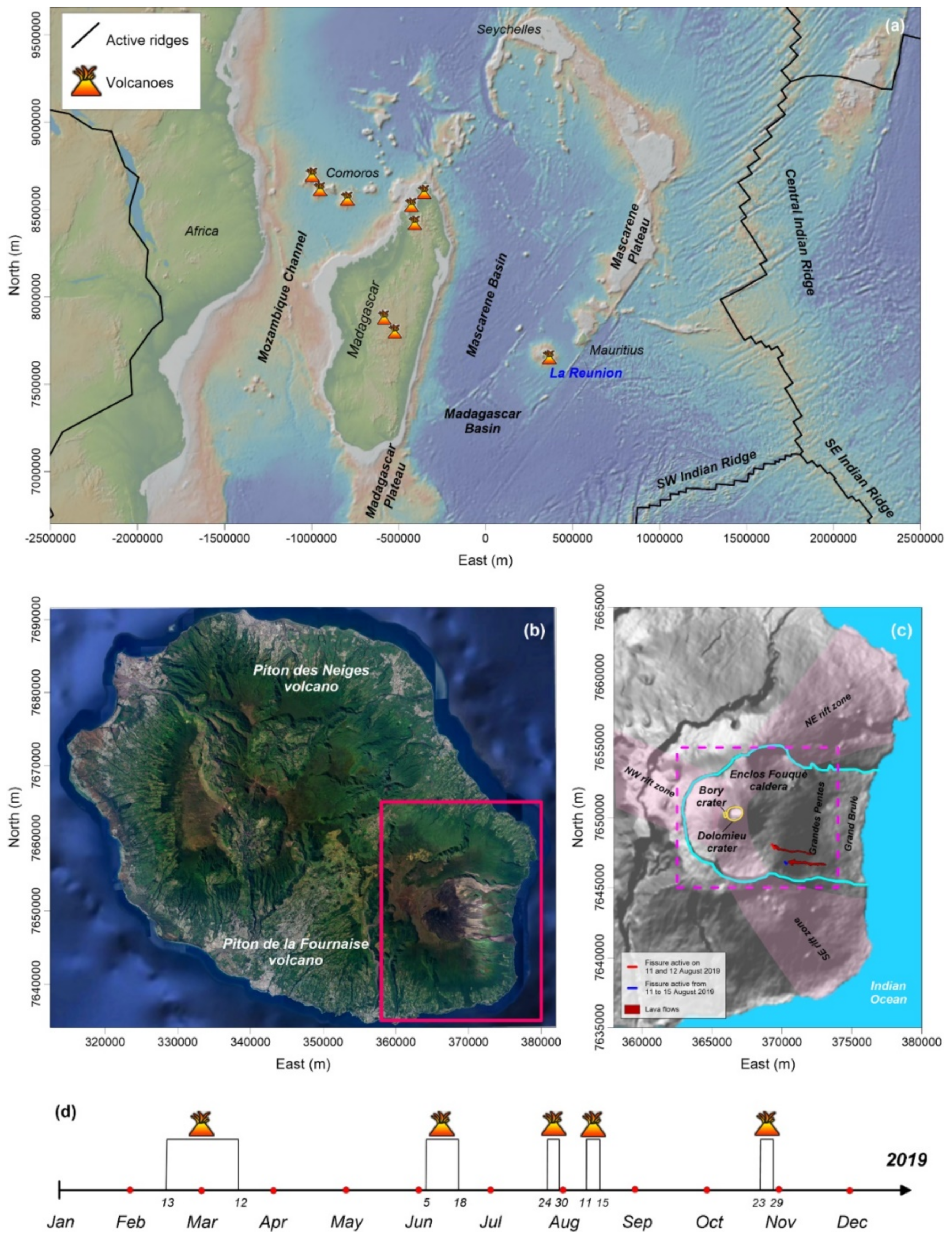

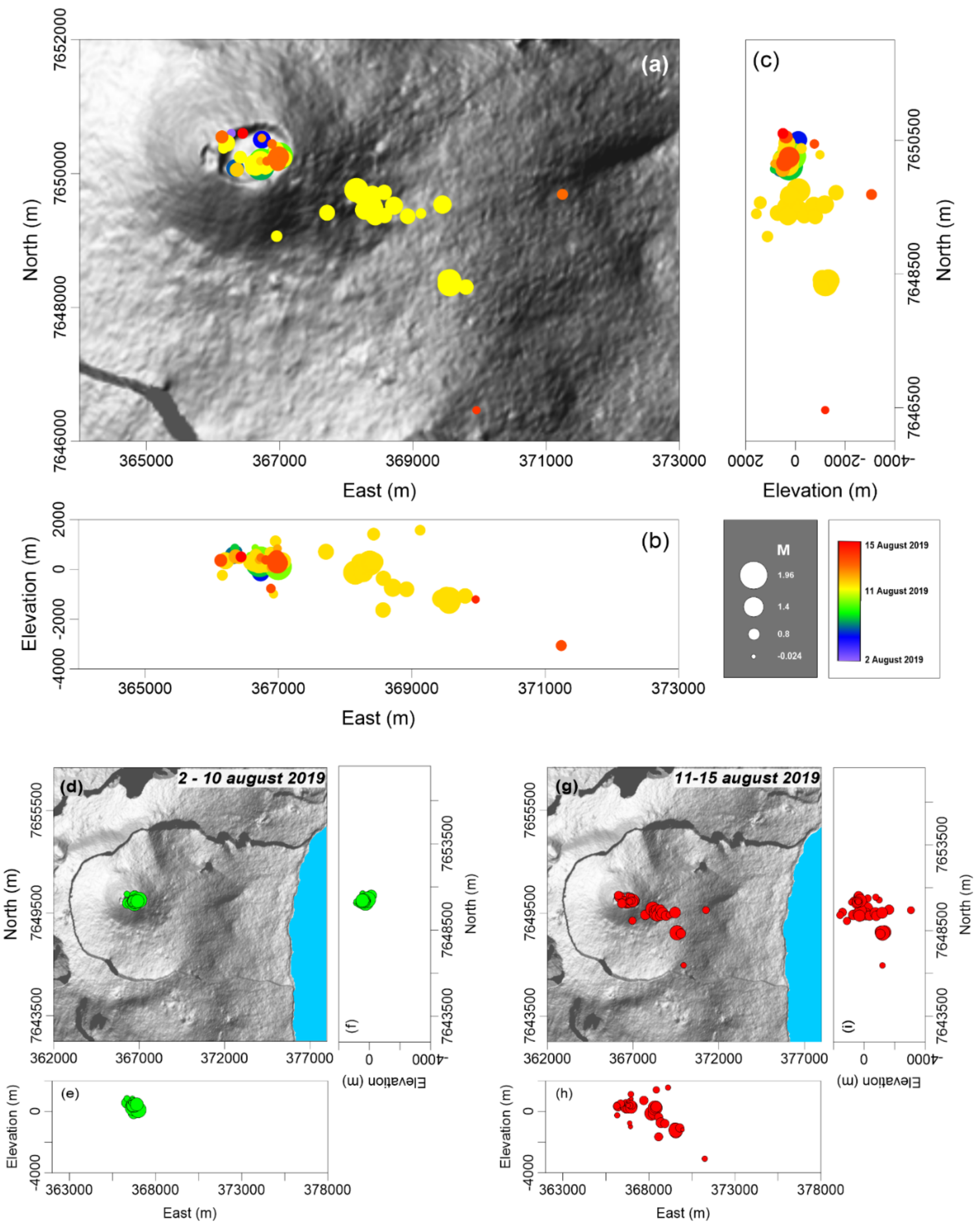
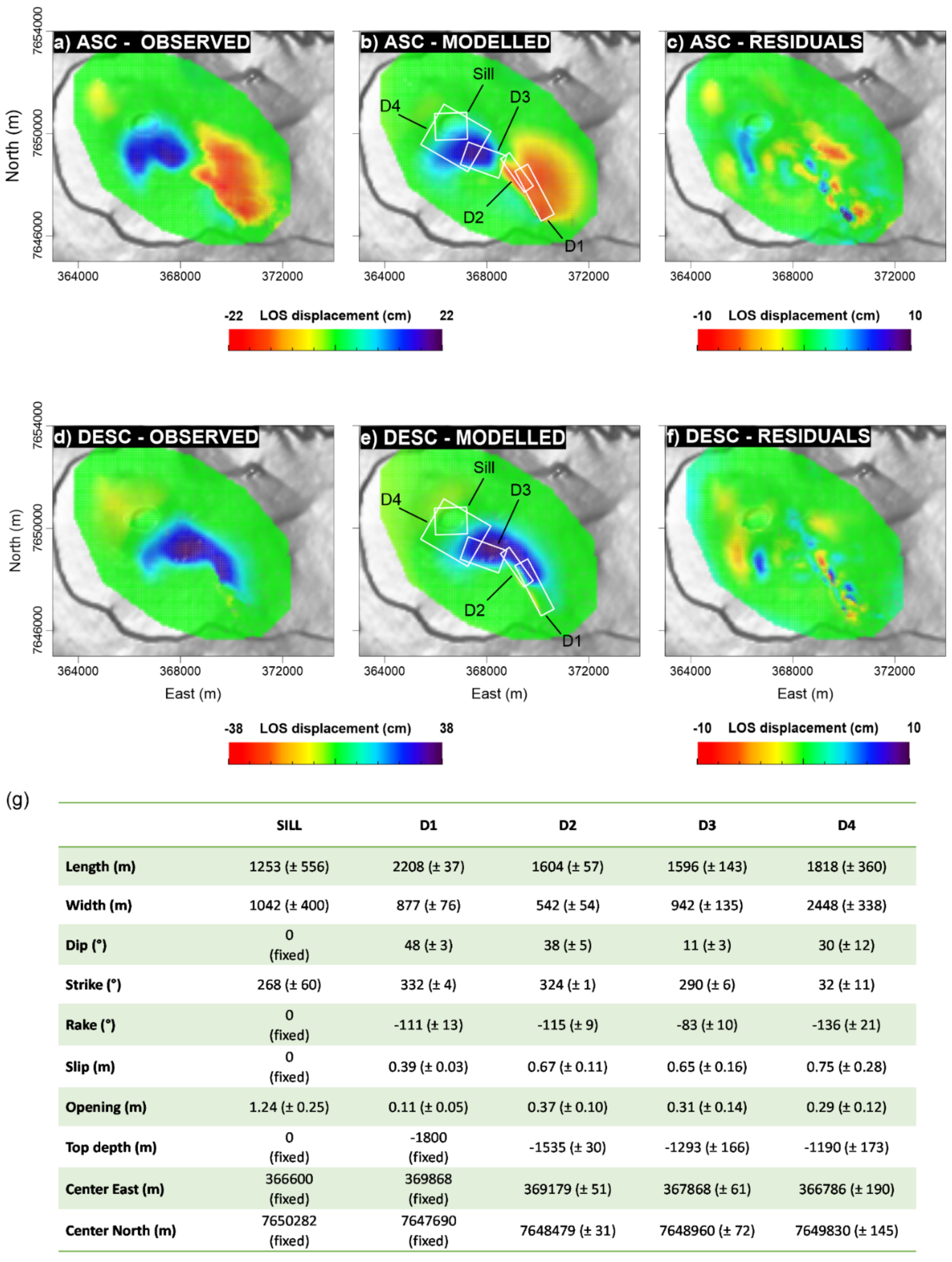
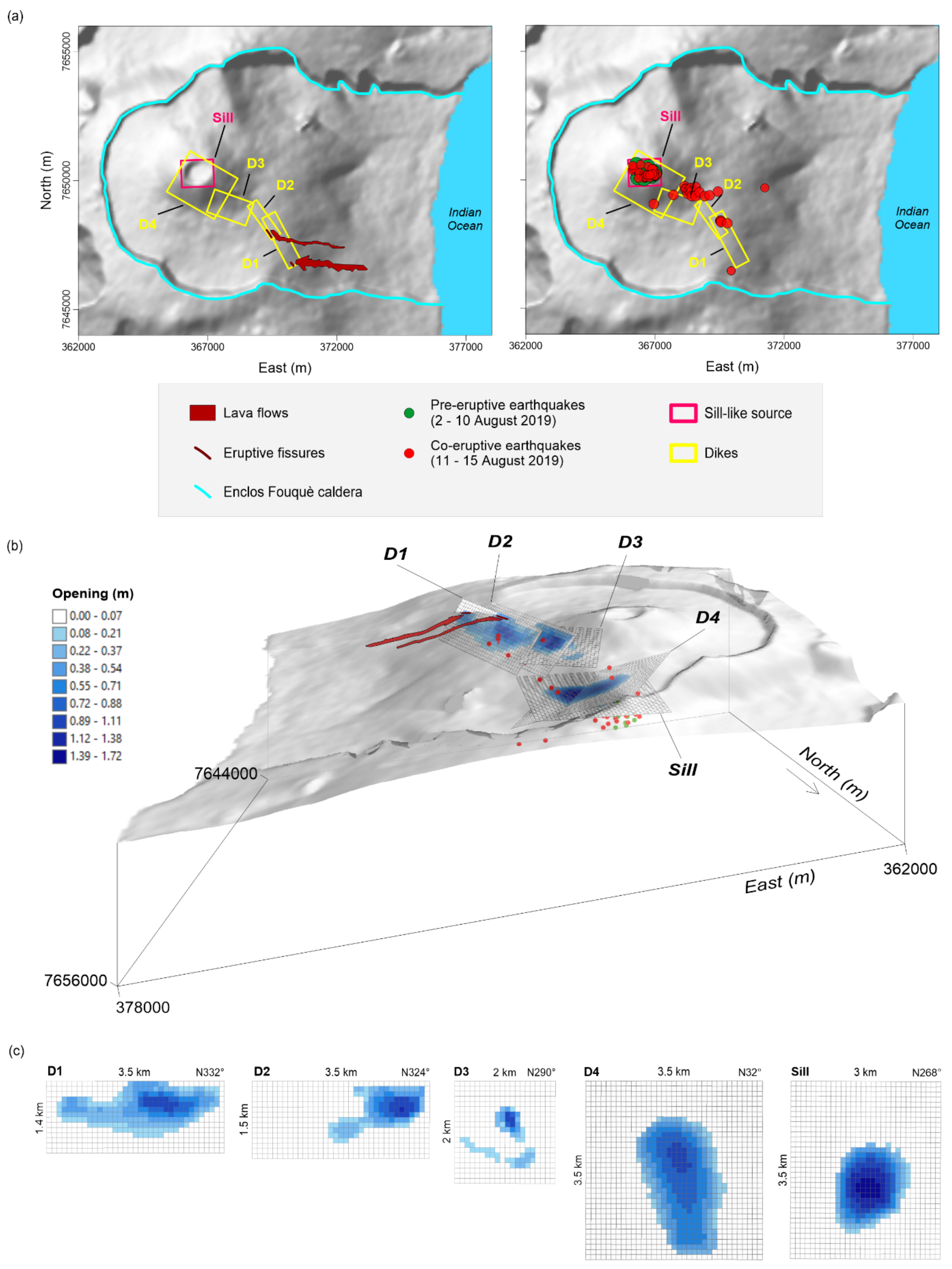
| Sensor | DInSAR Pair | Orbit | Track | Perpendicular Baseline (m) | Incidence Angle (deg) |
|---|---|---|---|---|---|
| Sentinel-1A | 02082019–14082019 | ASC | 144 | 67.9828 | ~42 |
| Sentinel-1A | 03082019–15082019 | DESC | 151 | −56.6627 | ~37 |
Publisher’s Note: MDPI stays neutral with regard to jurisdictional claims in published maps and institutional affiliations. |
© 2022 by the authors. Licensee MDPI, Basel, Switzerland. This article is an open access article distributed under the terms and conditions of the Creative Commons Attribution (CC BY) license (https://creativecommons.org/licenses/by/4.0/).
Share and Cite
Valerio, E.; De Luca, C.; Lanari, R.; Manzo, M.; Battaglia, M. The August 2019 Piton de la Fournaise (La Réunion Island) Eruption: Analysis of the Multi-Source Deformation Pattern Detected through Sentinel-1 DInSAR Measurements. Remote Sens. 2022, 14, 1762. https://doi.org/10.3390/rs14071762
Valerio E, De Luca C, Lanari R, Manzo M, Battaglia M. The August 2019 Piton de la Fournaise (La Réunion Island) Eruption: Analysis of the Multi-Source Deformation Pattern Detected through Sentinel-1 DInSAR Measurements. Remote Sensing. 2022; 14(7):1762. https://doi.org/10.3390/rs14071762
Chicago/Turabian StyleValerio, Emanuela, Claudio De Luca, Riccardo Lanari, Mariarosaria Manzo, and Maurizio Battaglia. 2022. "The August 2019 Piton de la Fournaise (La Réunion Island) Eruption: Analysis of the Multi-Source Deformation Pattern Detected through Sentinel-1 DInSAR Measurements" Remote Sensing 14, no. 7: 1762. https://doi.org/10.3390/rs14071762





